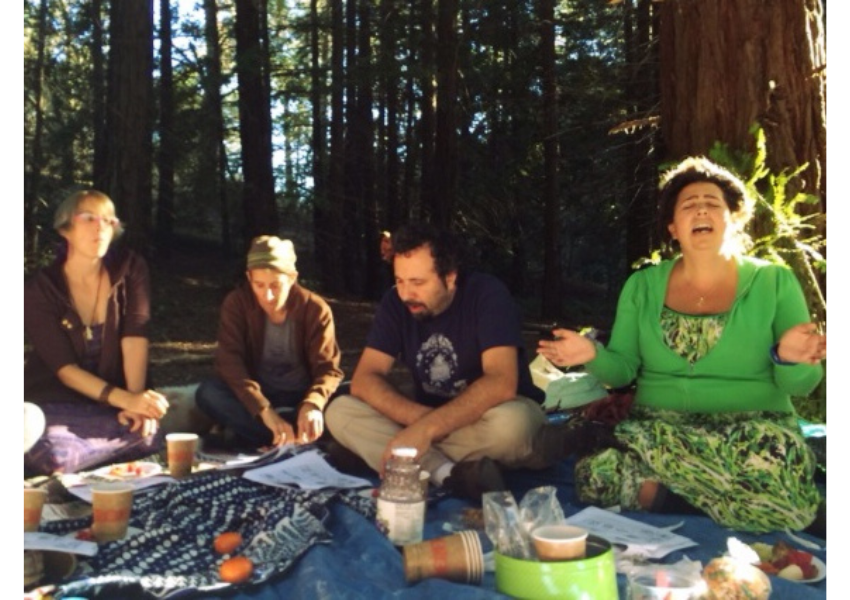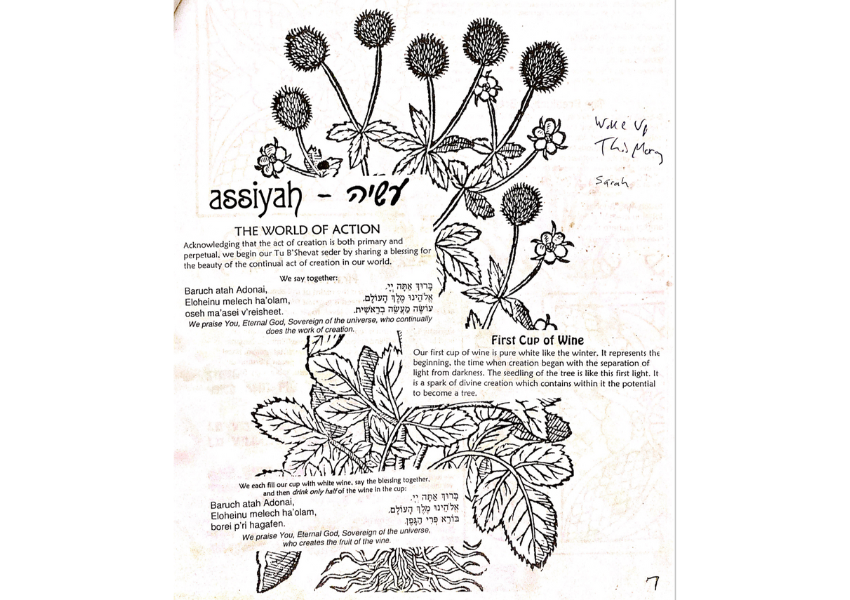The New Year of the Trees: Memories of Jewlia Eisenberg’s Rigorous Positive Tu BiShvat Seder
Published Jan 26, 2023

Memories of Jewlia Eisenberg’s Rigorous Positive Tu BiShvat Seder (Part 1/3)

Above: Jewlia leads a song at the Tu BiShvat Seder in the Redwood forest. (Photo Courtesy of AnMarie Rodgers.)
The Mishnah, in a discussion of the calendar, delineates not one but four new years, each with its own special function: the new year of kings, the new year for tithing animals, the new year of the seasons, and the new year of the trees. While the first two new years were operational only in the ancient Israelite kingdom and have ceased to be observed, the latter two have remained a part of Jewish life into the present. The new year of the seasons is celebrated as Rosh Hashanah, the beginning of the Jewish calendrical cycle. The new year of the trees, also known as Tu BiShvat (the 15th day of the Hebrew month Shevat), has taken on new significance in the last few centuries, first as a mystically infused celebration of redemption, allegorized in a poetics of growth from out of hidden seeds, and more recently as a Jewish environmentalist holiday, fostering a sense of kinship and interrelation of flora and humanity, encouraging activism ranging from planting trees to political organizing.
In this brief article, I will offer a few memories, of my own and from others, about the Rigorous Positive Tu B’Shvat Seders that were led every year in Redwood Park in the Berkeley Hills by musician and public intellectual Jewlia Eisenberg. Jewlia and I were close friends and musical collaborators for the last seven years of her life. In addition to her work as leader of the band Charming Hostess and other projects aligned with the Radical Jewish Culture movement, Jewlia was also active as a ritual leader, working for Jewish institutions in the Bay Area and beyond. She was also the leader of a close circle of intimates for whom she served as a social fulcrum and a kind of punk, sage-like spiritual guide. Jewlia took this role very seriously and carefully constructed rituals that were deeply attuned to the aesthetics and identity of her community, while at the same time rooted in her scholarship and commitment to Jewish religious texts, sounds, and ideas.
Memories of Jewlia Eisenberg’s Rigorous Positive Tu BiShvat Seder (Part 2/3)
Above: “Freedom Plow”, Book of J (Jewlia Eisenberg and Jeremiah Lockwood). This video was shot by Max Baloian and recorded by Nino Moschella of Bird and Egg.
The Tu BiShvat Seder was held in a clearing in the midst of a dense redwood forest. Usually falling in late winter, it was bracingly chilly, but almost always sunny, the midday light dappled by the shade of the trees. The seder was framed around the ritual drinking of four glasses of wine (or juice) following the progression from white to red set by 16th century Kabbalistic rabbis: the first glass would be all white, the second white mixed with red, the third red mixed with white, and the last all red. This journey from white to red represented the growth of a tree from the incipient energy of a seed to the flaming bloom of autumnal color. These colors also symbolizes the spiritual journey from the world of manifest physical experience to the realm of the ineffable.
As Jewlia’s widow, AnMarie Rodgers, highlighted to me, the Tu BiShvat Seder was part of a suite of ritual offerings that she and Jewlia would host each year that Jewlia officiated at. Pesach was the most important, but Rodgers and Eisenberg also hosted a week-long convocation each year in their Sukkah with a different theme for each night of the holiday. The Tu BiShvat Seder was kids-oriented, playful, and involved both singing and discussion.
As with her Passover celebration, Jewlia created a zine-like Haggadah for Tu BiShvat. The Haggadah gave the order of the ritual of drinking wine and eating fruits and nuts, and also included songs and readings. The songs ranged from Hasidic nigunim and Ottoman piyyutim to American gospel and labor union songs (above), all on themes related to the earth and its bounties. Each page was a delight of pastiche images and readings ranging from Hebrew prayer texts and song lyrics to historical details about the ancient Israelite cult of the Goddess Asherah, whose sacred tree was housed inside the Temple compound in Jerusalem.
Memories of Jewlia Eisenberg’s Rigorous Positive Tu BiShvat Seder (Part 3/3)

Above: A page from the Tu BiShvat Haggadah. (Photo courtesy of AnMarie Rodgers.)
Each level of the spiritual journey of the seder was embodied through drinking and eating special fruits. The final level, Atzilut, or divine emanation, has no physical representation in the Tu BiShvat ritual. Jewlia’s friend Natalie Bonnewit recalled the game Jewlia led each year at the seder to help the participants imagine this realm of impossible holiness and beauty. Each guest would be asked to design their own fruit that did not exist in this world.
Bonnewit reminisced, “Every year we collectively design the perfect fruit. Forever mine will be a firm exterior that protects the interior fruit, like an orange, but peels as easy as a banana. The interior color is fuchsia. The flavor is mango.” Jewlia wanted her intimates to be able to imagine the impossible and maybe even to find ways to bring the flavor of that impossibility into real life. Bonnewit shared with me that in the year after Jewlia’s tragic and untimely death, “we left a piece of [Jewlia] at our regular Tu BiShvat spot. Forever there, in the redwoods, designing the perfect fruit.”
Jeremiah Lockwood is a scholar and musician, working in the fields of Jewish studies, performance studies, and ethnomusicology.
Reflections
Joyful futures
Environmental catastrophe plays a major role in our lives today; it can be overwhelming to think about it, let alone try to come up with meaningful actions in response to this public crisis. What are some ways you can imagine bringing joy into our discussion of the future of the planet? In what ways can you imagine community and pleasure playing a role in our plans for how to achieve the future we want and need?
Making ritual
What are important parts of your life that you would like to see included and celebrated in Jewish rituals? Can you imagine ways to bring them in?
Taste of the infinite
If you were going to design your own fruit, what would it look like? What would it taste like?
Want more?
Get curated JewishArts.org content in your inbox


